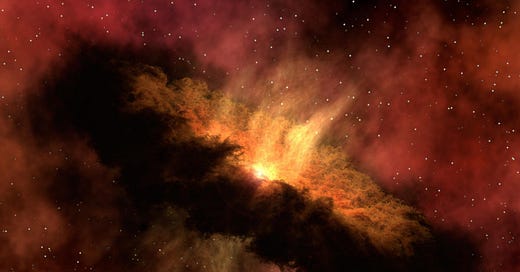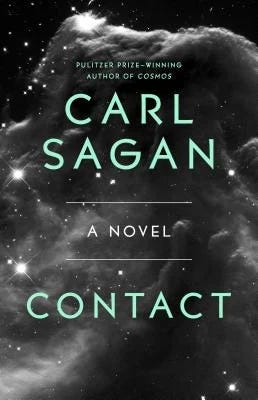For my money, Carl Sagan wrote one of the most beautiful speeches to be given in the last century. I am speaking of his famous “Pale Blue Dot” speech, in which he looks at a picture of earth taken by the Voyager 1 spacecraft in 1990. Earth, in the photo, is a mere speck of light, a “mote of dust suspended in a sunbeam.” It is impossible, looking at it, to feel significant.
The Voyager 1 was one of Sagan’s greatest projects: the famed astronomer, with his wife, science communicator Ann Druyan, placed a Golden Record inside the spacecraft which was meant as a kind of gift, a time capsule, to any alien civilization that should ever discover it. Among the sounds included were songs by Beethoven, Bach, Elvis Presley, Chuck Berry, and Azerbaijani folk music. There was also a recording of the brainwaves of a woman in love — Ann Druyan herself.
The Golden Record project itself was a hilarious encapsulation of humanity’s problems — EMI, who owned the Beatles song “Here Comes the Sun,” insisted on a $50,000 payment for its inclusion, which was more than double the project’s budget, so in some distant future, aliens may know something of earth, but will know nothing of the Beatles. Public outcry also kept Sagan from including nude images of human beings, because the aliens, presumably, would share our prudish sense of indecency.
Sagan was a scientist by trade, but in his later life he became a science communicator, best known for his hit series Cosmos. He also wrote one work of fiction, which was, after his death, adapted into a movie starring Jodie Foster: Contact.
“Where is everyone?”
Contact is a book by an inexpert fiction writer (no one ever taught Sagan the “show, don’t tell” rule), but it is interesting to me as a utopia. Sagan, after all, was perhaps the best communicator of the value of science in accessing feelings of awe that were usually reserved for the religious.
Sagan was a lifelong agnostic, believing that God could neither be proven or disproven, but he was also an optimist. He believed in humanity’s better angels (though it’s doubtful he’d use that term), and believed that it was best embodied by science as a whole.
Contact is his vision of how science could save humanity: in it, radio astronomers receive an alien message from the Vega system. They spend years decoding the message, finally understanding that the message is telling them to build a large machine.
The Search for Extra-Terrestrial Intelligence (SETI) was another of Sagan’s lifelong projects, and the main question this project posed was an enormous one: in 1961, astrophysicist Frank Drake created what is now known as the Drake Equation, which calculated the probability of there being other intelligent civilizations in the Milky Way Galaxy. Conservative readings of the equation suggest that there are very likely lots of civilizations out there, which begged a second question, most famously asked by physicist Enrico Fermi:
“Where is everyone?”
This question is now known as the Fermi Paradox — if there are likely many civilizations out there in our massive universe, why haven’t we heard from them yet?
The unifying threat of aliens
Sagan, among others, believed that the reason was that technological civilizations tended to self-destruct, either through war or through ecological collapse. In Contact, he imagines the possibility that we escape this fate through a sort of alien intervention1 — if an intelligent civilization contacted us, would we get our shit together?
Written in the context of the Cold War, one of the main conflicts of Contact is between the scientific community and the political community. Science flourishes best in openness, but much of science’s funding comes from military “defense” projects, which require high levels of secrecy. This is an eternal tension between science and politics: the recent movie Oppenheimer was an excellent demonstration of some of the difficulties of scientific cooperation with the military.
Because of the rotation of the earth, in Contact, nations across all longitudes would be required to listen for the full alien message. Radio telescopes in the United States could not, for example, collect the transmission from Vega for 24/7, because during certain times of day, Vega would dip below the horizon.
This basic feature of the planet earth means that a transmission like the one in received Contact would require humanity’s cooperation across national lines. U.S. military brass would obviously worry that they’d be giving away technological secrets to the Soviets (and vice versa), but a transmission from another star — which implies a level of technological advancement far beyond ours — might work as a sort of unifying threat.
Sagan’s aliens are, of course, benevolent, wise creatures who hope that humanity can transcend its petty rivalries and join the galactic community — the first transmission they receive from earth happens to be one of the earliest television broadcasts, of Adolf Hitler opening the 1936 Munich Olympic Games.
But his broader question stands: could humans begin to embrace a cosmic perspective? Would we ever be able to stop thinking of ourselves as Americans, Soviets, Chinese, etc., and start thinking of ourselves as humans?
Can science save us?
Sagan died in 1996, and did not live to see the modern climate change era, when scientists are now being roundly ignored even by nominally “progressive” Democratic politicians. As scientists have become more and more strident in their warnings about our planet’s future, the people in power have become more and more deaf to their warnings.
A more modern sci-fi author, Kim Stanley Robinson, put it succinctly in his book 2312:
“The space diaspora occurred as late capitalism writhed in its internal decision concerning whether to destroy Earth’s biosphere or change its rules. Many argued for the destruction of the biosphere, as being the lesser of two evils.”
It would be interesting to see how Sagan would’ve responded to this modern era, but it is worth noting he was living, while writing Contact and the “Pale Blue Dot” speech, through another existential crisis, the Cold War nuclear arms race. Contact is a far from perfect book, but it does understand that scientific enquiry relies on at least some level of political cooperation to function properly, and these two worlds are at best tense bedfellows. The President in Sagan’s Contact is a pro-science President, which in itself was an outlandishly optimistic literary device for a book being written in the age of Ronald Reagan.
The question for us now is a harder one to answer: can the scientific community save us when the political world is working actively against them? Can humanity come to terms with its insignificance and work together for a longer life out there among the stars?
Or Divine Intervention, if you prefer.





